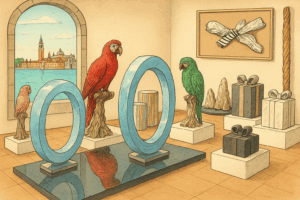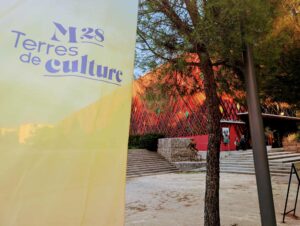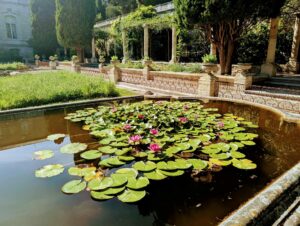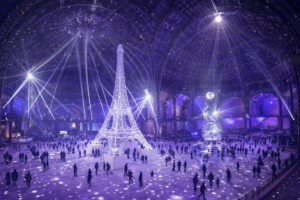The tapestry takes place in Aubusson, over the centuries
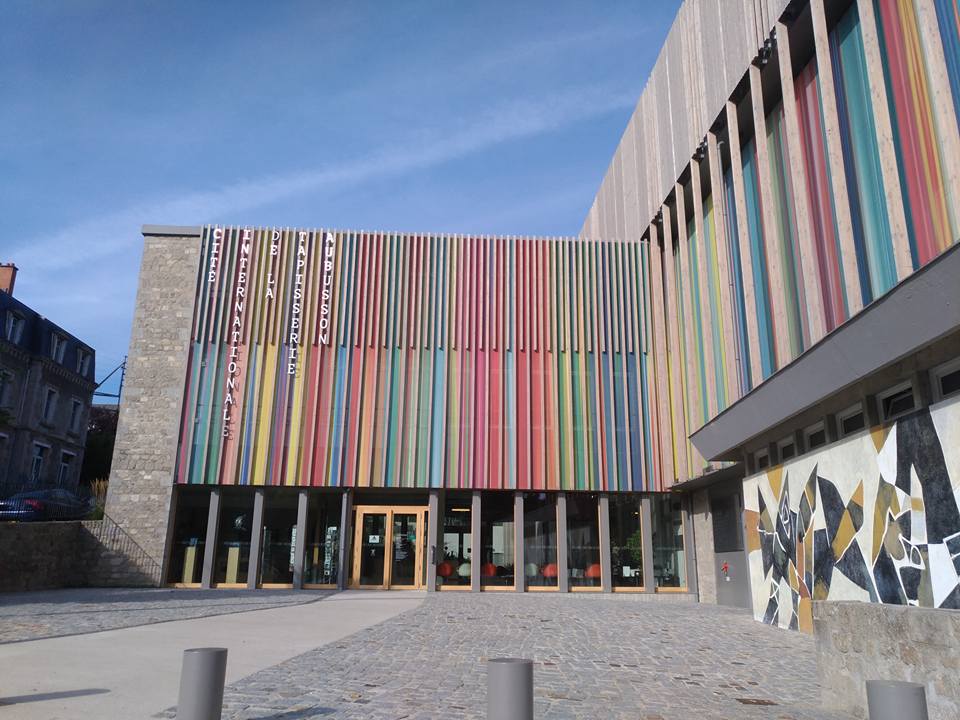
While in recent years, 13 museums have closed their doors in the heart of the new region of New Aquitaine, it tries to restore a cultural impulse by the inauguration on July 10, 2016 of the International Tapestry City, responding to a need for local tourism, through a course combining interactivity and elements of scenography particularly studied to highlight this ancestral Art of Tisse, through including the International City of Tapestry, which gave a boost of dynamism artistic in this part of the department of Creuse, impresses here and there frescoes straight out of the crafts-to-weaving.
The International City of Tapestry, a place of expression dedicated to the transmission of a Know-How
Since Antiquity, the tapestry has been used by many peoples for different purposes: carpets, horse blankets, clothes …
In medieval Europe appears the use of decorative and narrative medieval wall tapestries. The tapestry is done by hand with colored threads (weft threads) which completely cover the most often united threads constituting the framework of the textile (the warp threads). Unlike conventional weaving, the weft threads are interrupted with each color change.
Most often the result of a “hands-on work”, according to the terms of UNESCO and the advent in the 1960s of the movement of weavers-creators.
For 5 centuries and a half, we weave and restore in Aubusson where today reside 3 dyers, 5 independent card makers, 2 spinning mills, 8 craft workshops and 3 factories, which makes the city the pole of the tapestry in Europe; offering local employment, a sector representing 150 people.
The new Cité Internationale de la Tapisserie is the result of 3 years of renovation works on the foundations of the former School of Decorative Arts, designed in 1967 by the architect Robert Danis in the Latin Cross.
One of the only schools owned by the State and having means accordingly larger than the others related to local communities.

A renovation project initiated on these ancient walls in 2011, which no longer formed weavers since the mid-90s, for a cost of 8 million euros, at a price of 1,200 euros / m2, a together highlighting a palette of colors used in the looms that came to dress the facade, designed by the graphic designer Margaret Gray whose work is also expressed by the textile structure decorating the stairs leading to the mezzanine (Credits photo: Alexandre Plateaux).
In the end, a result rather bare in elements like false ceilings and a mixed cladding with fiberglass cloth to hide the insulation of places.


A garden composed of sedum, requiring little watering, keeping some elements of the old garden of the convent of Recollets / A bright entrance retaining original furniture (Photo credits: Alexandre Plateaux).
3 reserve spaces with 200 works stored according to their size on the 340 available to the museum, protected from the 2 biggest enemies of tapestries namely light and heat (Photo credits: Alexandre Plateaux).
A collection that will be enriched next year since the widow of Jean Lurçat bequeathed to the City nearly 1,000 boxes to the size of his achievements.


The reserve of the City / Saracen Embroidery, with technique of bedding done on an embroiderer’s stamp. On the right, in knotted stitches, soap-making style (Photo credits: Alexandre Plateaux).


A library resource center of 12,000 books, a restoration workshop (in photos) and a training center offers a BMA in “Arts and techniques of carpet and tapestry smooth” befits the premises and graduating 10 people a year, a course focused on the weaving of interpretation, working consort with a call for artistic projects opened annually by the competition awarding 5 laureates (Photo credits: Alexandre Plateaux).
The National Furniture Workshop, resulting from the relocation policy of Edith Cresson, is a duplication of the Gobelins Workshop and opened in 1994, with local recruitment with a team of 20 workers who share the restorations ( both heritage pieces, National Furniture and Embassies).
In addition, 3 workshops of the City are available to master weavers, one with rent in kind for a public reception service. Indeed, many services are offered to him to make him as aware as possible of this artistic technique always open to vocations of new talents.
 Currently, Patrick Guillot, accompanied by 2 workers, weaves the work entitled “Pietà for the First World War” of a size of 4.50m x 4.50m, Thomas Bayrle, supported by the group Würth who has sponsored the acquisition of the model for 20 000 € and for a total production cost of 140 000 €, as a commemoration of the 14-18 war, which will be unveiled to the public, after 2 years of work, in November 2017 at the memorial Franco-German Hartmannswillerkopf based in Wattwiller (Photo credits: Alexandre Plateaux). Thus, a new public weaving market is emerging …
Currently, Patrick Guillot, accompanied by 2 workers, weaves the work entitled “Pietà for the First World War” of a size of 4.50m x 4.50m, Thomas Bayrle, supported by the group Würth who has sponsored the acquisition of the model for 20 000 € and for a total production cost of 140 000 €, as a commemoration of the 14-18 war, which will be unveiled to the public, after 2 years of work, in November 2017 at the memorial Franco-German Hartmannswillerkopf based in Wattwiller (Photo credits: Alexandre Plateaux). Thus, a new public weaving market is emerging …


A space presenting representations of the carpet from all directions / A more tactile approach to weaving styles (Photo credits: Alexandre Plateaux).


In the museum’s itinerary, 4 platforms of digital know-how allow the visitor to enter the manufacturing process, as evidenced by this exhibition path mixing modernism and tradition as well as these installations exhibited at the Platform of Contemporary Creation in Paris. upstairs, from left to right: “The river at the edge of the water”, Olivier Nottellet / “Blink # O”, Benjamin Hochart / “Confluentia”, Bina Baitel (Photo credits: Alexandre Plateaux).
A sensory itinerary for the blind public is in preparation for the year 2017 with the assistance of the association Braille et Culture.

“Les 3P” by Mario Prassinos (1970), in the entrance to the Cité, freely inspired by the features of his grandfather (Photo credits: Alexandre Plateaux).


Another highlight is the “Nave of the Tapestries” where the visitor is provided with an illustrated guide, tablets and “blower holes”; audiovisual device, another reminder to the theatrical staging of the hall.
Result of an installation by Rouland and Paoletti and trompe l’oeil paintings from the Atelier Antoine Fontaine (Photo credits: Alexandre Plateaux).



On the right, the mythical “Millefleurs unicorn” (15th century) (Photo credits: Alexandre Plateaux).
The installation shows the evolution of the Tapestry through Ages and styles, nevertheless the nineteenth time remains to be completed because of a general state of conservation less for this time, they are more rare …
Shades appear as and when between manufacturing techniques between Beauvais where the cost per m2 was 4 000 euros against 500 euros for Aubusson which is distinguished by its simplicity and greater room for maneuver more to stick to the means time, making it possible for more artists to be produced.
With the objective of the management to change annually in the Nef (600m2 on 1,200m2 of surface) half of the collection, and loans including contemporary funds will be possible through the upcoming internet bet of the fund.



“Untitled”, Mathieu Mercier (2011) / “Shadows”, Man Ray in collaboration with the publisher Marie Cuttoli (1938) (Photo credits: Alexandre Plateaux).
An essential starting point for each tapestry, cardboard …
In parallel with a massive use of Jouy paper between 1780 and 1820, the first boxes appear in the nineteenth century, thanks to the appearance of gouache, new colors arrive. They are also highlighted by the work done by the creators of the Aubusson Tapestry Carton Museum next to the Atelier de Chantal Chirac and its Contemporary Space presenting until 30 July 2016 the work mixing painting and tapestry. Mireille Veauvy.


Views from inside the Carton Museum (Photo credits: Alexandre Plateaux).


Then, a small detour through the Old Center of Aubusson and its quays of Creuse is needed … (Photo credits: Alexandre Plateaux).
The Jean Lurçat Center, the parent of the Cité de la Tapisserie
Originally, the Departmental Museum of Aubusson tapestry inaugurated in 1982 was intended to present the history and collections of tapestries Aubusson and Felletin located in the department of Creuse and the Limousin region.
In 2011, motivated by the inscription of the Aubusson tapestry to the intangible cultural heritage of humanity by UNESCO in 2009, the start of the expansion project of this site, dedicated today to one of the masters Jean Lurçat Tapestry, will result in the transfer of the bulk of the reserves instead of the new International Tapestry City.
Today, this center has a space that is still significant enough to present the public with masterpieces and large scale of the artist.


Entrance of the Jean Lurçat Center and “The Conscript of the 100 villages” (Jean Lurçat, 1947).
The visitor will be able to remember two significant periods of the career Jean Lurçat, a first in 1937 and 1942 where he appropriates Aubusson, to “create a new tapestry for our time” in the words of the curator of the City of Tapestry, Bruno Ythier who also declares: “Without the School of Decorative Arts, there would not have been Jean Lurçat and its overflowing production. Without Jean Lurçat, there would not have been the restart of Aubusson after the war through mass production and lower costs. “Moreover, it will operate locally by funding local artists.
The second period runs from 1944 until his death in 1966 where he will experience the apogee of his Art, including the use of restricted ranges in color and a symbolic universe composed of bestiaries, without any previous model (drawing in miniature) but a direct creation of cardboard (often scale 1).
He was very influenced by poetry, and he worked to put them in weaving of which “Freedom” of Eluard where irony of the History, in 1943, the Gestapo went down in his clandestine workshop and seeing the work woven to the backwards, did not understand the meaning.



Some prowess of Jean Lurçat often realized by the Atelier Tabard d’Aubusson: “The Time” (1958), Self-portrait of the artist (Photo credits: Alexandre Plateaux).
Castle of Boussac
A stone’s throw from Aubusson lies the Boussac estate.
Site having had many owners over the ages and undergone several metamorphoses, serving as former gendarmerie of the smallest sub-prefecture of France in 1926.
In addition, a dungeon destroyed in the Revolution, with revolutionaries having had the desire to end any sign of feudalism.


An annual tapestry exhibition this year, from May to September, works by Georges Chazaud (in photos) woven in the lair of Raymond Picaud’s workshop and sculptures with the effigy of dogs by Françoise Meneveux ( Photo credits: Alexandre Plateaux).



The owner of the premises, Mrs. Bernadette Blondeau, exhibits her personal collection of nearly 350 canes and her personal creations from elements of nature nearby or even a re-enactment of the period of detail (Photo Credits: Alexandre Plateaux).


The renovation of this exceptional place is undeniably a passionate commitment of a lifetime since she has been working on it for 50 years with her husband Lucien Blondeau, with a particular attention to develop each space of the castle closer to its historical context using vintage furniture items from the best specialists. Above, the room known as “the Archbishop” and an impressive collection of crystalware (Photo credits: Alexandre Plateaux).


Thus a Renaissance part is predominant with an immense room of the guards, covered with original beams and Aubusson tapestries of Louis XIV period including Soliman the magnificent and where stands a monumental fireplace decorated with symbols Ermine and broom of the Labrousse family (Photo credits: Alexandre Plateaux).


As well as the Salon Zizim, symbol of the particular care taken on an original scenography without false note, we are far from imagining the recent presence of a gendarmerie in the premises!
Indeed, the Turkish prince Djem was sent into exile in Malta and landed in Creuse and allegedly made a passage in this gilded prison because of the conflict with his older brother reigning in Constantinople (Photo credits: Alexandre Plateaux).


 The castle bears the trace of the passage of George Sand who stayed there several years, having had in particular an official room of which certain elements still remain today (Photo credits: Alexandre Plateaux).
The castle bears the trace of the passage of George Sand who stayed there several years, having had in particular an official room of which certain elements still remain today (Photo credits: Alexandre Plateaux).


(Photo credits: Alexandre Plateaux).
Fleeing his stronghold of Nohant during the War of 1870 and following a cholera epidemic between 1860 and 1880, George Sand found his lover of the time Prospere Mérimée, in this room she found “filled with nasty furniture of the Empire “, and that it embellished its romantic imprint by bringing him pastel touches and clocks also found at the castle Schönbrunn. In her neighboring room, she wrote her first rural work “Diary of a traveler during the war” or is the action of his novel “Jeanne” where she describes what she saw from her balcony.
The carved village of Masgot in the shadow of François Michaud
On the upholstered roads of the department, why not make a stop by the village of carved, located in the municipality of Fransèches? An entire village adorned with granite carvings carved by François Michaud, a work initiated in 1850 until his death in 1890. Several themes of representation such as animals and other spooky creatures have spread at the entrance of the houses that crisscross this town, including that of the artist currently visitable and restoring a limousin interior of the nineteenth century.
In addition, the Center de la Pierre offers both children and adults introductory and advanced courses in stone carving.

 Masgot, a visit at his own pace … (Photo credits: Alexandre Plateaux).
Masgot, a visit at his own pace … (Photo credits: Alexandre Plateaux).
History is told at The Bridiers Historical Fresco
One of the 5 major events of this type in France, with Castillon-la-Bataille in New Aquitaine.
For the 11th edition, on a medieval site completely renovated of 5 hectares, with an amphitheater of 2000 places.
400 volunteers will notably reproduce on stage the tapestry planned in Aubusson for the “Pietà for the First World War”, to celebrate the centenary of Verdun.
With this year this show called the “fiancée de Verdun” narrating the story between a young hairy Creux meeting a Parisian nurse.
The whole narrated, all emotions, by Pierre Bellemarre, and for a cost of 200 000 euros over 4 days to be able to draw from a reserve of thousands of historical costumes.
The 2017 edition will be part of the Millennium celebration of the city of La Souterraine, and will be named “Alberric, the Millennium child”.
The day of the fall of crafts of the tapestry of the “Pietà for the First World War”, in July 2017, a delegation of extras will also be present at the Cité Internationale.
The Bridiers Historical Fresco: August 5, 6, 7 and 8, 2018 at the Bridiers site (23).


